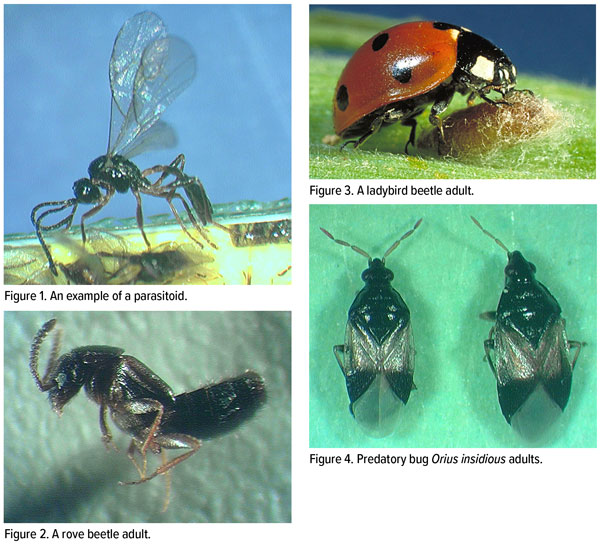2/1/2024
What Does “Compatibility” Mean?
Dr. Raymond A. Cloyd

Biological control is a proactive plant protection strategy that involves releasing biological control agents (BCAs), such as parasitoids or predators (Figures 1 and 2), in greenhouse production systems to manage insect or mite pest populations below economically plant-damaging levels. However, there are cases where BCAs aren’t effective, not commercially available or their use may be too expensive. Therefore, greenhouse producers are interested in integrating or combining (simultaneously using) BCAs with pesticides (insecticides and miticides) to manage insect and mite pest populations.
The reason for integrating or combining biological control agents with pesticides may be associated with: 1) insect and/or mite pest populations developing resistance to currently available pesticides; 2) increased costs and regulations affiliated with registering new pesticides; and 3) concerns related to pesticide residues on plants.
Integrating BCAs and pesticides may provide long-term management of insect or mite pest populations than either strategy alone. However, the effects of pesticide applications on the biology, behavior and reproduction of BCAs is complex. Furthermore, there may be instances where BCAs and pesticides shouldn’t be used together.
The current terminology or verbiage associated with using BCAs and pesticides simultaneously is confusing. For example, the term “compatibility” is often used in scientific and trade publications, but “compatibility” doesn’t address the effect of pesticides on BCAs from a quantitative assessment.
For instance, what level of survival or mortality (based on percent) of BCAs, when exposed to a pesticide, constitutes “compatibility”? Even mortality levels less than 50% can delay a parasitoid or predator population for one generation, which could substantially affect management of an insect or mite pest population. In addition, mortality levels more than 50% can affect establishment of BCAs, thus influencing their effectiveness in managing insect or mite pest populations.
Here are examples of label information associated with the effects of pesticides on biological control agents:
■ “Does not adversely affect populations of beneficial insects or mites.”
■ “Compatible with the use of beneficial/predacious insects or mites.”
■ “Does not significantly impact most predaceous arthropod complexes.”
■ “Compatible with beneficial arthropods.”
■ “Compatible with most biological control organisms used for pest control.”
Again, the terminology and verbiage has no quantitative meaning. When assessing the effect of pesticides on BCAs, the terms direct and indirect may be more appropriate, indicating a quantitative assessment that determines the possibility of integrating BCAs with pesticides. Integrating or combining BCAs with pesticides to manage insect or mite pest populations will only be successful if the pesticides used don’t directly or indirectly affect survival, reproduction or foraging behavior of the BCAs.
Direct effects are associated with acute mortality or survival of the active life stages (larva, nymph or adult) of BCAs over a given time period (e.g., 24 to 96 hours). Indirect effects—sometimes referred to as “sublethal,” “cumulative” or “chronic” effects—are related to the negative effects of pesticides on reproduction, longevity, mobility, searching and feeding behavior, and/or prey consumption of BCAs. Consequently, the indirect effects of pesticides can inhibit the ability of BCAs to manage insect or mite pest populations below economically plant-damaging levels.
Indirect effects of pesticides on BCAs may be a consequence of differences in exposure based on feeding behavior. For example, predators such as ladybird beetles (Figure 3) with chewing mouthparts that consume prey may be exposed to pesticide residues on the pest exoskeleton (cuticle), whereas predators—including predatory bugs such as Orius spp. (Figure 4)—with sucking mouthparts may be less exposed because of selective consumption of prey tissues.
Parasitoids, in general, are more susceptible to certain pesticides than predators, which is a function of indirect effects, including reduced survival, longevity and reproduction. However, the direct and indirect effects of pesticides on parasitoids varies depending on the life stage (egg, larva, pupa and adult) exposed to pesticide residues.
In conclusion, integrating BCAs and pesticides is complex due to the various direct and/or indirect effects that pesticides may have on BCAs. For instance, any delay in the population growth of BCAs by pesticides (and even fungicides) can substantially affect the ability of BCAs to manage pest populations below economically plant-damaging levels. Another factor to consider is that combining BCAs with pesticides not only has to effectively manage pest populations, but also has to be cost-effective. Finally, we need to stop using the term “compatibility.” GT
Raymond A. Cloyd is a Professor and Extension Specialist in Horticultural Entomology/Plant Protection at Kansas State University in Manhattan, Kansas. He can be reached at (785) 532-4750 or rcloyd@ksu.edu.